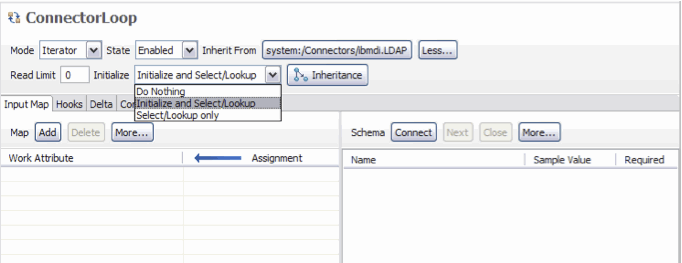Component panels
When we open a component in the AssemblyLine we will get a quick editor panel in the lower part of the AssemblyLine window.
We will get this for the following components:
- IF/ELSE/ELSE-IF Branch
- Switch/Case Branch
- For-Each Attribute Value
- Conditional Loop
- Connector Loop
- Attribute Map
IF/ELSE/ELSE-IF Branch
Quick Editor for IF/ELSE/ELSE-IF Branch

The IF and ELSE-IF branch lets you specify simple expressions and a custom script that returns true or false. Use the Match all checkbox to return true only if all conditions evaluate to true (AND mode). If unchecked only one of the conditions must match (OR mode).
The ELSE branch has no parameters.
Use the Add button to add new rows of Attribute/Operator/Value controls. We can remove these rows using the Delete button. The value can be a constant or an expression. Use the expression editor to configure the expression by clicking the button following the value text field. The move buttons are used to reorder the expressions. The expressions are evaluated from top to bottom. We can also change the branch type (that is, IF, ELSE and so forth) using the drop down below the title.
Switch/Case Branch
The Switch configuration has a number of options to select a value. This value is used to match the values in the contained Case branches. When they are equal the Case branch is executed. The switch branch is always executed.Switch/Case Branch

Selection options we can choose for your Switch/Case branch are:
- Work Attribute
- Select from the list of known work attributes
- AssemblyLine Operations
- Select from the list of know AssemblyLine operation names.
- Work Entry Operations
- Use the operation value from the work entry (for example, work.getOperation() method).
- User Defined
- Here we can specify our own value.
Use the Add Default Case button to add a default case. The default case will execute in the event that none of the other case branches matched the value from the Switch component.
For-Each Attribute Value
Attribute Value loop

This component loops over values in an attribute. Specify the work entry attribute name to loop over (work attribute name) and the loop attribute name. The loop attribute name is set to the current loop value from the work entry attribute (for example, foreach f in work.attr.values; set loopattr = f).
Conditional Loop
Conditional loop

The conditional loop lets you specify simple expressions and a custom script that return true/false.
Use the Addbutton to add new rows of Attribute/Operator/Value controls. We can remove these rows using the Delete button. The value can be a constant or an expression. Use the expression editor to configure the expression by clicking the button following the value text field.
The Match All checkbox determines whether all lines must match (Match all checked) or if only one needs to be true for the branch to execute.
Connector Loop
Connector loop

The Connector loop uses the Connector editor to configure a connector. There are a few differences though as shown in the above picture. The initialize option now shows those options relevant for a connector loop instead of the normal initialize options. Also, only Iterator and Lookup can be selected from the Mode dropdown.
Apart from the usual tabs we see for a connector, there is also an output attribute map that lets you configure dynamic assignments of connector parameters in the Connector Parameters tab. This is slightly different from the ordinary output map in that it shows a fixed schema, which is the list of parameters for the chosen connector. The schema part also has no Connect/Next buttons to affect the schema.
Connector Parameters in Connector Loop
Attribute Map
Independent Attribute Map Component

The attribute map component shows a single panel where we can map attributes to the work entry, independent from attribute mapping inside other components like a connector. The component also offers to reuse attribute maps from other components such as connectors, functions and other attribute map components in your library. For more information, see Attribute Mapping and Schema.
Parent topic: The AssemblyLine Editor